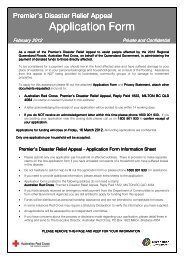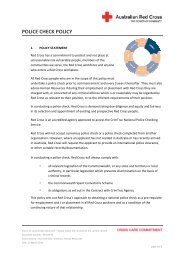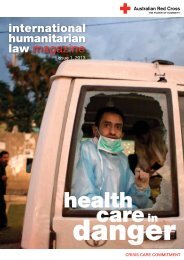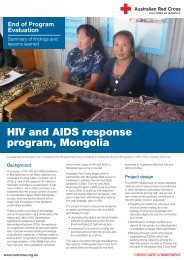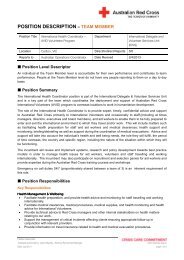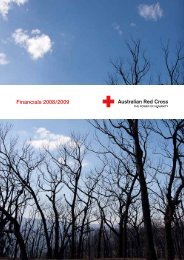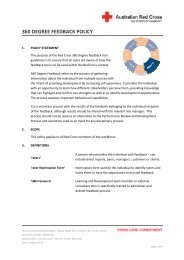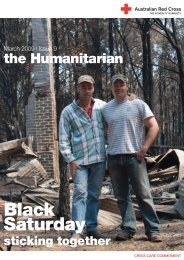Australian Red Cross Delegates Program
Australian Red Cross Delegates Program
Australian Red Cross Delegates Program
- No tags were found...
You also want an ePaper? Increase the reach of your titles
YUMPU automatically turns print PDFs into web optimized ePapers that Google loves.
10<strong>Delegates</strong> <strong>Program</strong> Annual Report 2011-2012> CASE STUDYSupporting localresponses<strong>Australian</strong> <strong>Red</strong> <strong>Cross</strong> delegate CATHERINE GEARING explains howsupporting Philippines <strong>Red</strong> <strong>Cross</strong> manage community-based projects,with design documents and baseline surveys, is critical to achievingsustainable outcomes for communitiesEleven-year-old May Ann is washing her hands, twining her fingers together,fastidiously scrubbing beneath the nails. “It’s so I don’t spread germs and get sick,”she explains, a shy smile spilling across her face. The tap she is using, and thewater tank that feeds it, are still new to May Ann’s small elementary school in themountains of La Union province, Philippines. Built by Philippine <strong>Red</strong> <strong>Cross</strong> withAusAID funding, these facilities are intended to reduce water-borne and hygienerelatedillnesses among the students.The taps and toilets are connected to a central rainwater tank by a standardsystem of supply and drain pipes. But supporting the entire project is an intangibleinfrastructure of documentation, research and evaluation, as critical to success as atoilet that flushes.<strong>Australian</strong> <strong>Red</strong> <strong>Cross</strong> delegate Catherine Gearing is one of the key architectsbehind this infrastructure. For nearly two years, she has been assisting Philippine<strong>Red</strong> <strong>Cross</strong> to build its capacity to manage community-based health and disastermitigation projects funded by international donors.“I started my mission as a disaster adviser but it’s become broader and I’m nowlooking at components of health, water and sanitation projects,” says Catherine.“I work closely with the teams in the Manila headquarters as well as the staff in thechapters.”Catherine’s mission is crucial in ensuring that projects demonstrably achieve theirintended outcomes, actually improving the lives of the most vulnerable.Projects like the school-based water and sanitation project in La Union began witha needs assessment to identify the real health needs within the community andwhether they aligned with <strong>Red</strong> <strong>Cross</strong>’ capacity to provide support. Catherine’sinput is often to ensure that a wide cross-section of the community is consulted,including women, people with disabilities and especially children. “Children havesome of the highest needs in relation to health and are often the most impactedduring a disaster,” she explains.The needs assessment at the school identified that children at the local elementaryschool regularly experienced incidences of diarrhoea and gastroenteritis, thatchildren needed to bring in drinking water from home, and that the majoritypopulation at the school was Ibaloi, an indigenous community that received littleadditional support from other sources.





